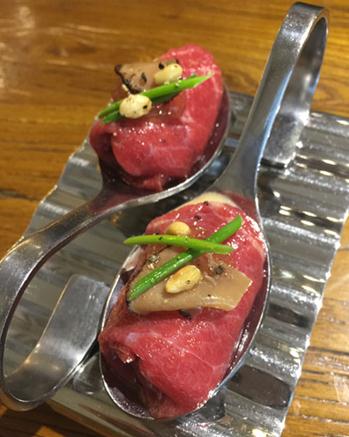
Korean fried chicken and carpaccio in spoons are among the menu items served at Andrew Ahn's restaurant One Pot in Sanlitun SOHO in Beijing. (Photo/China Daily)
Coming next is a carpaccio served in a spoon as a single bite. Ahn learned to cook Western cuisine in his early career at W Hotel in Seoul and later was chief cook in an Italian restaurant in Dubai's Burj Al Arab hotel for two years. He can mix his mastery of Italian cuisine with Asian taste, hiding the sesame sauce behind the raw beef, for example, so when we put the carpaccio into our mouths, it really gave us a surprise!
The main courses for the lunch are traditional Korean fried chicken and bulgogi with noodles. Unlike the American fried chicken, which is dry outside, the Korean chicken pieces are served drizzled with different sauces - spicy or garlic or plain - on the crust, but the sauces never make the crisp coating soggy.
The bibimbab in the restaurant is served in a pot instead of stone bowl, a way that Ahn promotes his new concept "One Pot". There are 13 ingredients in the pot, including eggs, ginkgo fruit and cucumber.
The dessert for our big lunch is ginseng tiramisu - another meeting of Western and Asian cuisine. Unlike Chinese people, though, Ahn says: "Koreans think that people should have ginseng in summer, when people are hot outside but cold inside. And ginseng can get you warm inside."
Ahn doesn't like to use MSG: He wants the food to show off its natural taste. But he got complaints from customers who said the food didn't taste like they expected. ("I have had MSG my whole life before!" one said.) So Ahn put a small bottle of MSG on the table so customers could help themselves. "No problem," he says.
Ahn is a chef that enjoys experiment in cooking, and he is making plans to open a high-end Korean fine dining restaurant in Jeju island. He plans to offer more seasonal Korean at that seaside location, because "the ingredients are very fresh there".
"Only three dinners a week, only by reservation," says the 41-year-old. "I will use the rest of the time to develop myself - to try things and learn things. It will be like a lab."
At a glance
Many Korean side dishes (banchan) get their flavor (and preservation) from fermentation. They have a tangy, salty, and spicy taste.
Bibimbap means "mixed rice" in Korean. If you have any vegetables in the fridge, you can mix them up with rice in a one-pot dish.
Rice was extremely pricey when it was introduced to Korea, so it was mixed with other grains to "stretch" it. This is done today in dishes such as boribap (rice with barley) and kongbap (rice with beans)
Medicinal food (boyangshik) is a wide variety of specialty foods, including seaweed and ginseng, prepared and eaten for better health, especially during the hottest days of summer. Consuming "hot" foods is believed to restore one's vital life force, as well as sexual and physical stamina sapped by oppressive heat.


















































